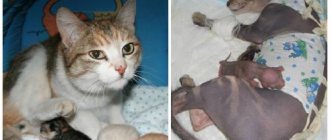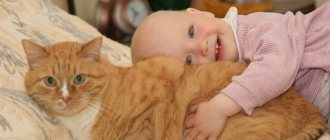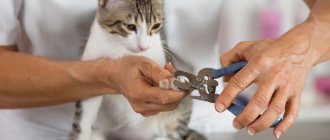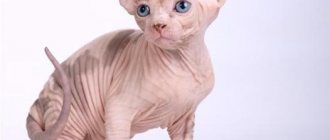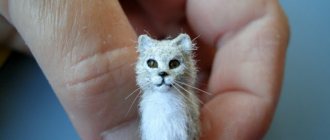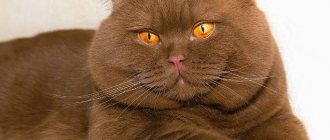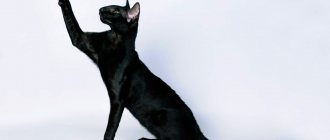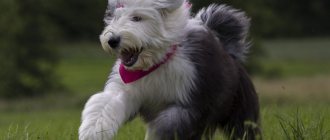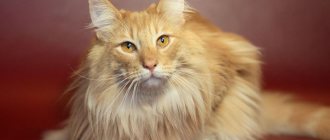The young breed of Bambino cat appeared not so long ago and has not been sufficiently studied. The Bambino is a Sphynx-Munchkin mix that has passed on its distinctive genes: short legs and no hair. Externally, the breed resembles a dachshund.
The period of appearance of the breed was 1999 in the USA, Osborne. She was bred completely by accident, but managed to gain great popularity among cat lovers, especially those who suffer from allergies.
These cats have delicate skin that feels like velor. There are similarities with the sphinx, but bambinos are much more sympathetic to humans due to a number of distinctive qualities. The owners of these pets note their unpretentiousness in food and care, affection, and love for the owner.
Appearance of a cat
The main characteristics of the bambino's external features are listed in the table, but may vary slightly. The most beautiful individual is considered to be the bambino with bright blue eyes and short legs, such as can be found at exhibitions.
Show cat bambino
| Torso | Stocky, strong, barrel-shaped body. Pronounced muscles. Height is from 10 to 20 cm. Average weight is from 2.5 to 5 kg (males are larger in volume than cats). Adults reach 3 kg with a normal balanced diet. |
| Head | The large, lemon-shaped eyes are set wide apart and come in a variety of colors. The ears are straight, fairly large, wide at the base, set far apart. Heart-shaped head. |
| Paws | Short, muscular, folds gather closer to the fingers. Participation in exhibitions is granted only to individuals with short legs. |
| Tail | Long, thin, without folds, in some cases there is a tassel at the end. |
| Wool | There is no hair, in some cases it is on the ears, paws, muzzle, tail or scrotum. The skin color is predominantly light with the addition of gray and pigmentation. |
| Lifespan | from 7 to 15 years. |
Description of the miniature breed of hairless cats
Bambinos are small animals. The height of an adult cat is 20–25 cm at the withers; weighs no more than 3–3.5 kg. Males are slightly larger, they can reach 4.2 kg. Distinctive features are short, dense legs and lack of hair.
Despite their short legs, bambinos are very curious and active cats.
Appearance
All representatives of the bambino breed must meet the following parameters:
- Head: wedge-shaped, slightly longer than wide. The cheekbones are prominent, the whisker pads (cheeks) are convex, but the whiskers themselves are absent. The neck is short and dense.
- Eyes: large, slightly slanted. The main colors are blue and green. Yellow and gray eyes are less common.
- Ears: very large, wide at the base, tips may be drooping. A small amount of fluff (“velor”) is allowed on the skin on the outside of the ears.
- Body: long, muscular, equal width at the shoulders and pelvis. A slight rise of the back in the hip area is allowed.
- Skin: smooth, with many folds.
- Limbs: permissible length - 1/3 of the height at the withers. The direction of the feet is strictly straight. The pads are wide and dense. The front legs visually have short forearms, the elbows are pressed to the body.
- The tail is equal to the length of the body, wide at the base and slightly tapering towards the tip.
Bambino is a hairless cat, but a small amount of fluff (no more than 2 mm) is allowed. Short hairs may be present on the ears, tail, and bridge of the nose. Skin color can be any, including spotted.
Characteristic features of the bambino are lack of hair and short legs.
Character
They quickly become attached to people and rarely show signs of aggression. They are distinguished by their cheerful disposition and mobility. Despite their short legs, they run quickly (they resemble ferrets when moving), but they cannot jump high.
They are considered highly adaptable cats. They are friendly to strangers and loyal to other animals. They are willing to make contact with children if they do not harm them. They do not tolerate loneliness well. If left alone for a long time, bambinos begin to panic.
It was in one place, that's for sure. But they are wonderful. I have a whole flock. Now, a hurricane of several bambinos, led by Ozy, is rushing from the kitchen into the room. He is their boss. He will sit on the stand, or rather lie down, squint his eye and watch how the little ones below are fiddling around, then he will run into this heap and the heap begins. They are so funny. And to understand them, you need to talk longer, they are completely different if you compare them with sphinxes.
Kalinka
https://sphynxportal.com/forum/lofiversion/index.php/t7480.html
Other Features
To preserve the characteristic features of the breed, bambinos must be crossed either with representatives of their own breed or with Canadian Sphynxes. No other options are allowed (even with related munchkins and minskins). The fact is that the hairless gene is recessive; if one parent is hairy, then all kittens will be born furry.
History of the breed
A US family in Osborne first saw the strange breed of kitten - the result of crossing a Sphynx with a Munchkin - and were struck by its cute appearance and suede-like skin. The couple accepted the ridiculous kitten into their nursery and took care of registering the new breed. In 2006, the bambino breed was registered with the International Cat Association (TICA) as an experimental breed. The couple came up with the name of the breed themselves.
Munchkin
Sphinx
Breeding in Russia was carried out by a breeding specialist. The breed was registered in the Russian Federation in 2005, called Minskins, but after registration in the international registry they received an American name.
Basic information
| Breed name: | Bambino |
| Country of origin: | USA, Osborne |
| Period of appearance of the breed: | 1999 |
| Type: | Home |
| Average weight: | 2.5 - 5 kg |
| Height at withers: | 10-20 cm |
| EMS code: | BMB |
| Average life expectancy: | 7 – 15 years |
| Prices for kittens: | 100 — 1050 $ |
Breed standard
A document regulating the important characteristics and description of a cat breed is called a breed standard. It is used by breeders and breeders to assess the conformity of animals with their pedigree characteristics and by livestock specialists when grading farm animals or by judges of exhibition events when determining the degree of pedigree characteristics.
Zootechnicians are specialists in the issues of breeding, keeping, feeding and caring for farm animals, assessing their benefits and quality in the final product with the least amount of labor and funding.
Valuation is the determination of the productivity of the qualities of animals by assessing them according to a number of characteristics of the breed.
Bambinos have the following parameters specified in the standard:
- head of medium size, elongated towards the top of the head;
- the mustache is completely absent or short in length;
bambino muzzle
bambino muzzle:
- straight skull with clearly visible cheekbones;
- nose straight;
- the neck is powerful, of medium length;
- small chin;
- expressive eyes are located widely apart and have the shape of a lemon;
- the ears are leaf-shaped, set far apart, wide at the base;
- the body is muscular, the legs are short but wide, the shoulders and hips are the same width;
- the shoulders are muscular, the back is slightly curved upward, the chest is round;
- medium or heavy skeleton;
- The length of the shoulder is equal to the forearm, and the lower leg is equal to the thigh;
- paws are oval with long toes pointing forward;
- the tail is long, powerful, smooth, rounded at the end.
Education and physical activity
Despite their mischievous nature, bambinos are easy to train. Cats with short legs easily get used to the feeding schedule and quickly master the skills of using a tray and scratching post. In addition to the basic rules of behavior, representatives of the breed are able to remember about 10 commands like “Come to me!” or “Bring it!”
Nimble and active, bambinos have anatomical features that limit their jumping ability. Therefore, they do not need high sports complexes. And so that cats with short legs have something to do, they buy a lot of toys for them.
Colors and coat
The body of this breed is not covered with hair or has hairs up to 2 mm all over the body or in some areas.
There are clusters of folds on the neck, muzzle, forelimbs, and are barely noticeable on other parts of the body, except for the ears, back and tail. A large number of folds or their complete absence is an indicator of a lack of breed. Below is a photo.
What does a bambino look like according to breed standards?
Colors range from soft pink to dark gray or blue, pigment spots may be present. The eyes always have rich color and brightness.
Exterior Features
According to international standards, cats of the Bambino breed are distinguished by shortened limbs and bald bodies. Representatives of the breed have highly developed muscles and are distinguished by a wide chest. A taut, rounded tummy gives the impression of a “pumped up” four-legged pet. Sexually mature individuals have a body weight not exceeding four kilograms. Males are much larger than females. The main external criteria include:
- muscular shortened limbs with pronounced phalanges and powerful claws;
- long body with a developed muscular skeleton;
- movable elastic long tail without hair with a tassel at the edge;
- erect large ears with rounded ends;
- wool is completely absent;
- the presence of folds on the body is mandatory (excess, absence is unacceptable according to the standard);
- large eyes with an iris of gray-blue, yellow-green color;
- the shape of the head has a wedge-shaped outline, the crowbar is covered with deep wrinkles in which sebaceous secretions and dust collect.
The first Bambino kitten was the result of an accidental crossing of parents of different breeds. Subsequent specimens were bred artificially to maintain the breed's population.
Character
Bambino is translated from Italian as “child”, this definition is completely suitable for these pets. The activity and curiosity of bambinos knows no bounds; they are very friendly with their owners, guests, other animals (cats, dogs, rats), and love children.
Cats are companions on any journey with their owner, they easily endure travel, become strongly attached to a person, remain loyal, feeling as comfortable as possible in his presence.
They are ready to explore everything around them, be active for a long time, run well, but jump only short distances.
Characteristics of the bambino
| Attachment level | High |
| Friendliness | High |
| Suitable for children | Yes |
| Loyalty to other pets | High |
| Exercise needs | Average |
| Playfulness | High |
| Energy level | Average |
| Intelligence | Average |
| Tendency to meow | High |
| Shedding intensity | Low |
Allergy
Bambino is an ideal solution for those who have family members who are allergic to cat hair. Such a cat either has no hair or has small hairs that do not affect the allergy receptors.
In rare cases, irritant reactions may occur to the protein secreted by the breed, which is produced on the surface of the skin by sweat glands or during urination.
If you don't pay enough attention to caring for your cat's skin, it may begin to peel off, which will stimulate the receptors, causing sneezing and itching on the skin and eyes, especially if the person in contact has an allergy to dust.
Cat fluff and hair cause allergies
It’s easy to find out whether a bambino will cause allergies: just spend about two hours communicating with it.
Color
As already mentioned, the breed has three color variations: black, bluish and white.
- Blue. Gray-blue spots are visible on the skin in a chaotic manner. Also, more than 50-70% of the skin may have a blue tint. Eyes are standard blue.
- Gray. Raven color from top to bottom. The eyes are also colored blue.
- White. They can have either completely clear skin or small dark spots on the paws, ears, nose, and muzzle. Eye color can vary from yellow to blue.
Bambino, due to its peculiarity (lack of hair), has very thick skin with folds. Even when the animal stretches out at full length on the carpet, you will not see perfectly smooth skin.
Maintenance and care
When purchasing an active bambino, it is better to provide him with plenty of space to play and run around. He doesn't need a special sleeping place. It is much more important to pay attention to his playground, which can be represented by a labyrinth with frequent and low steps.
Play tunnels must have a long distance, but move to a height carefully, gradually, and it is also advisable to create additional safety from falls or the cat’s desire to jump from top to bottom, for example, by laying a soft landing pillow under the hole.
If the bambino frequently jumps to heights, you should provide an additional object so that the cat can jump to the target without injuring bones and joints.
Grooming
This care includes ear care, eye care, including nail trimming and skin care.
- It is recommended to clean the ears weekly using a cotton pad soaked in a special solution (purchased at a pet store). Using circular movements, dirt, grease and shine are removed from the ear.
- The eyes are washed with chamomile; it is sold in the pharmacy in the form of a packaged flower collection. Chamomile soothes the delicate skin around the eyes, clearing away impurities and secretions and protecting against harmful bacteria.
- It is enough to wipe the skin with baby lotion to remove dirt and moisturize it, preventing peeling.
Bambino grooming includes cleaning the ears, eyes, skin care, and trimming the nails.
The pet's delicate skin requires additional care.
Moisturizing the skin of a bambino is not a difficult procedure compared to grooming a fluffy cat.
Bathing a cat
Bathing procedures are carried out once a month to ensure the cat is comfortable and maintains hygiene. Pets need water treatments, because they also get dirty when they play, eat, sleep, lick themselves, and relieve themselves. Bambino skin is very delicate and there are specialized shampoos for this breed that are designed to care for hairless skin.
The shampoo is applied using a soft sponge or by hand in warm water. The area of the ears and muzzle is washed with a cotton pad or a small sponge, so as not to cause discomfort and unpleasant sensations in the cat from water getting into the eyes, nose, mouth, and you should be careful with the ears.
Bathing a bambino cat
A hairless cat loves warmth, so clothing for such cats often helps solve the problem of temperature control in the house. They treat clothes calmly, even comfortably, feeling warm and soft.
Eating bambino
These cats do not suffer from overeating due to their activity and strong mobility, are not susceptible to allergic reactions, and have a good metabolism.
You can feed the bambino the same food as other cats: ready-made dry or wet mixtures, natural food.
Natural nutrition should include boiled meat, poultry, rabbit meat, vegetables and grains.
Adult cats eat 3 times a day, kittens - up to 6 times.
Among the purchased feed mixtures, the following manufacturers are distinguished: ACANA, Royal Canin, Pro Plan, Natural amp, Hill's Science.
Royal Canin specialized food for sphinxes and bambinos
You can use food for sphinxes. The listed brands have already taken care of balancing the nutritional value with mineral and vitamin complexes; the food is offered depending on the weight and age of the cat; details can be found on the packaging in the directions for use.
Purchasing a kitten
Bambino is suitable for all animal lovers with a cheerful character. There is no need to be mistaken about the hypoallergenic nature of these cats. Some people have an intolerance to the protein Fel d 1, which is found in cat saliva and sweat, or Fel d 4, which is found in cat urine. Experts strongly recommend spending 1-2 hours in the company of these animals before purchasing. If in the process of communicating with a cat a skin rash, sneezing, or nasal congestion occurs, it means that it is better to cancel the purchase of a kitten of this breed.
Criterias of choice
You should not buy animals secondhand from unverified people. These are rare cats and, most likely, through private advertisements they will sell you a kitten that does not meet the breed standards. There are cases when scammers try to pass off a cheaper Sphynx or Minskin as a Bambino.
Some tips to help when buying a bambino:
- Buy bambino through nurseries where this breed is bred. In our country, such nurseries as “Murmlet”, “Ot Cotture”, “Marquise”, “Nika”, Cats & Company, “Favorit”, “Diamant Crystal”, “El Grand”, Baby Moon Cattery specialize in dwarf hairless cats.
- Be sure to study the baby's pedigree. Ask to see his parents (ideally they should both be bambinos, but it is possible for one parent to be a Sphynx - but this should reduce the cost of the kitten).
- Be sure to inspect the animal before purchasing. The main requirement is for the skin and paws. The first one should be smooth, without hair (except for the fluff on the ears and tail). Limbs no more than 1/3 of the length at the withers.
- The kitten should be cheerful and playful. Aggression is not typical for bambinos.
- Despite its short legs, the animal runs quickly and jumps to a small height. A cat should not limp or constantly fall over (this indicates pathologies of the limbs).
- When standing and walking, the kitten's back should be straight; strong bending or hunching in the lumbar region is not allowed.
When choosing a bambino, you need to look not only at short legs and lack of hair, but also at ensuring that the cat does not have strong arches in the back when standing
The age at which it is better to take a kitten from its mother
For the first two months of life, bambino babies are kept in isolation from the outside world, because due to their bald skin they are sensitive to temperature changes and can easily get hurt or catch a cold. It is better to take the animal from its mother after 3–4 months. Such kittens are already prepared for independent life - they know how to feed themselves, go to the toilet, and will not experience severe stress from being separated from their mother cat.
At 3–4 months, the kitten is no longer so attached to its mother, it can be taken home
Health and illness
Dermatitis or rash on the skin of the Bambino.
The bred and registered breed appeared as a new one not so long ago. It will take many more years for a complete description of the diseases to be collected, but some features have already been noted.
- As a result of poor skin care, dermatitis or minor peeling may appear due to a lack of vitamins, temperature changes, insufficient nutrition or lack of hydration.
- Individual manifestation of allergic reactions, which is quite rare, but quite possible.
- The occurrence of tumors without sterilization and constant estrus in a cat without subsequent pregnancy.
- Hip dysplasia in rare cases due to structural features.
- Hereditary diseases: lordosis and hypertrophic cardiomyopathy.
Bambinos cannot jump as high as regular cats.
Short-legged cats cannot climb to great heights in one jump - a closet or a refrigerator. The bambino's short legs, which make them different from other cats, are actually not such a gift for these kids.
These little ones need something like steps so that they can gradually, in small jumps, rise as high as they want.
There will be no such opportunity - the cat will constantly experience stress, and even in games with ordinary animals, short-legged cats often look helpless. You won’t be able to hide from the enemy, even in a game, in an instant. So the Bambino breed, whose photos seem ominous to many, is in fact quite defenseless.
Pregnancy and childbirth
The best age for the first mating is 1.5 years. Bambino offspring average up to 5 kittens. There are no difficulties in pregnancy; cats cope well with childbirth and feeding.
The owners' responsibilities include providing quality food and creating conditions for caring for the kittens. The cat will make it clear that the baby's bed is uncomfortable when it begins to move them to another place. It is important to pay attention to how the cat reacts to the prepared kitten bed before the birth itself.
During your first pregnancy, you should be monitored by a veterinarian.
Mister Cat Recommends: Temperament Features
Bambinos have a unique character. These cheerful and kind cats never show aggression towards anyone. Therefore, they easily get along with any pets - their other brothers, dogs, birds, guinea pigs. They will not hunt a parrot or a mouse.
These kids will play for the rest of their lives. They adore the owner and all household members, especially children.
They are smart, highly trainable, and able to remember simple commands.
Short legs do not prevent pets from running and jumping. Bambinos maintain an active lifestyle even into old age.
They like to sit on their hind legs with their front legs folded over their chest. The “dreamer” pose, the prerogative of the Sphinxes, is also characteristic of them.
They do not tolerate loneliness well. They are happy to accompany their owner on trips and travels.
Kittens
Bambino babies are very similar to Sphinxes, but as they grow older, they change and the number of folds decreases.
Bambino leather is velor, very soft. This is one of the advantages of the breed that Sphynxes do not have.
Kittens are fed 6 times a day; after 1.5 years, feeding becomes like that of an adult cat.
Bambino kittens
Breeders prepare bambino kittens for sale by vaccinating the kittens and performing anthelmintic procedures in order to give a completely healthy baby to a new home. Kittens are ready to leave their mother at the age of 4 months.
Advantages and disadvantages
The disadvantages of the breed include:
- high price for kittens from the nursery: from 40 to 400,000 rubles (depending on the package of documents, gender and peculiarities of skin and eye color);
But connoisseurs of luxury can note this feature, on the contrary, as an advantage, because there are fewer owners of such an interesting breed; not everyone can afford to buy an exotic pet.
- do not react well to the cold, freezing without clothes or in a cool room;
- require skin care, it is especially necessary to clean the folds.
Advantages:
- active and friendly;
- have a good appetite;
- hypoallergenic;
- Excellent companions for the owner: they can easily endure trips, travel, love and are not afraid of children, get along well with other animals.
Bambino care
The breed is known to have many of the characteristics of Sphynxes and Munchkins. Along with their unique appearance, some people like them because they tend to be very affectionate cats.
They are known to be playful and enjoy being surrounded by company.
This is not a cat that you would regularly leave for long periods of time. They can be suitable for families with gentle children and other animals as they are very sociable and friendly.
Despite their shorter legs, bambinos are known for being energetic and surprisingly agile. You will need to make sure that you have plenty of toys in the house.
This will help keep them entertained and prevent them from developing problem behaviors due to boredom. However, their shorter legs may tire more quickly and they may not be able to jump as high or far as a cat with long legs.
Some people may be attracted to bambinos because they consider them to be a hypoallergenic breed. While it's true that their dandruff may not be as profuse as cats with fur, they still have a very slight dander. It may still cause allergies in some people.
Their coat also requires much more attention than that of the average cat. This is one of the contradictions of the breed. Their lack of fur means they are much more sensitive to cold and their skin can easily become injured.
They are also much more likely to suffer from sunburn.
If you do take your bambino outside, make sure they are wearing cat-safe sunscreen or that they do not go outside in very sunny weather. They are best suited for indoor living.
Because they don't have the normal absorbent coating, their skin tends to be much oilier. This means they may be more susceptible to developing skin problems such as bacterial and yeast infections.
Unlike regular cats, they will require regular bathing to keep their coat clean.
Breeding
Crossbreeding two adult bambinos on your own is unacceptable; it is dangerous due to the appearance of mutations in kittens. The breeding of this breed is always accompanied by professional geneticists and felinologists. You can purchase kittens of this breed in nurseries: Mirmagnificent (Sochi, Russia), Shococats, Joser (Moscow, Russia); LilNudists, Forest For Film, Kyty Kittens (USA).
You can buy a bambino kitten in a nursery in Moscow or Sochi
It is not safe to buy bambino kittens by hand. The point is not only that they may have mutations or diseases, but that scammers often pass off the Canadian Sphynx as a bambino, which significantly affects the price of the animal. In this case, you can overpay several times, and the cat will not grow up to be what you expected it to be.
Buy a bambino - tips and tricks
It is better to take the baby from a nursery where sphinxes, as well as elves and bambinos are bred. Before purchasing, you should study the price list of the selected nursery. Pre-order a video call and examine the kitten online. Useful contacts are found during specialized exhibitions. It is unsafe to buy such a pet from someone else, especially on an advance payment basis. Fraudsters are passing off Sphynx kittens as bambino kittens.
Price
The answer to the question of how much such an individual costs depends on its type. An ordinary pet will cost 90 thousand rubles, and a breeding pet, for example, bambino cat breed, will cost about 350 thousand rubles. The cost of elite individuals can reach $5,000. The amount of expenses will increase, since you will need to spend money on food, vitamins, a house, special cosmetics, etc. If a kitten is adopted from a cattery, the future owner has approximately 4 months to prepare everything necessary.
Interesting Facts
Bambino on a walk in clothes
- The peculiarities of friendly communication are associated with the lack of a hunting instinct, which is why they are often kept together with representatives of rodents and birds.
- Any cat is afraid of children and does not let them near them, but bambinos are recognized as the best friends for children.
- This breed has no whiskers at all or is too short in length.
- Skin without fur is susceptible to peeling, requires additional care, and is also afraid of direct sunlight and precipitation when walking, so it must wear clothes.
- The bambino breed has been included in the Register of Rare and Exotic Animals since 2006 by the Rare and Exotic Feline Registry Association. And TICA included this breed in the experimental group until several generations confirm the stability of the hereditary traits.
Castration and sterilization
If the owners do not have a goal to breed bambino, then it is better to artificially stop the animal’s reproductive functionality. The procedure for removing the sex glands (testes in cats and ovaries in cats) is carried out according to a standard procedure. Recovery after surgery is easy. Castrated and sterilized bambinos do not cease to be cheerful and active, and there is no tendency to obesity with proper nutrition.
At what age is it recommended to have surgery?
The earliest age at which a bambino can be castrated is six months. Before this period, surgery is prohibited, since the full development of the internal organs is not complete, the testes are “hidden” in the abdominal cavity or in the area of the inguinal ring. Cats need to be sterilized even later - starting at eight months of age.
Caring for your pet after surgery
If the castration or sterilization procedure went without complications, then the rehabilitation period will not take more than a month. Immediately after the operation, the animal should be placed in a warm place, wrapped in a blanket. Do not leave the animal near the radiator or in direct sunlight - bare skin can quickly burn.
Hairless cats have no hair and get cold quickly. If the animal is trembling, it should be wrapped in a blanket
It is important to ensure complete rest for the operated bambino. The animal should not be nervous; it will try to jump on its paws and run away to hide. Such activity may cause the seams to come apart.
It is important to monitor the condition of the postoperative wound for two weeks. Sutures must always remain dry and clean, not fester, not become inflamed, and not bleed. To prevent infection, the sore spot is treated with antiseptic agents (dioxidine, chlorhexidine, hydrogen peroxide). Every day the animal should get better - appetite and good mood should return. If this does not happen, you should contact your veterinarian so that he can conduct a thorough examination of the cat.


